Tiny bumps that appear on the skin, especially on the face are generally tagged as pimple – but not every skin bump is a pimple, although they may look and feel the same. These bumps come in different shapes and sizes with most being totally harmless. Bumps on your skin are caused by a variety of factors, according to the AAD, American Academy of Dermatology, acne a type of skin bump is caused by blocked pores that become infected by bacteria.
Acne, however can be managed at home or changing your skin care regimen. Other bumps that pose as acne aka pimple are usually nothing to worry about – as long as it doesn’t bleed, turn darker or change in a concerning way – if these signs are present, it could be associated with a more serious health issue. See a board-certified dermatologist immediately.
Read on to uncover the 16 common bumps that can be found on your skin and how to deal with it.
1. Comedones
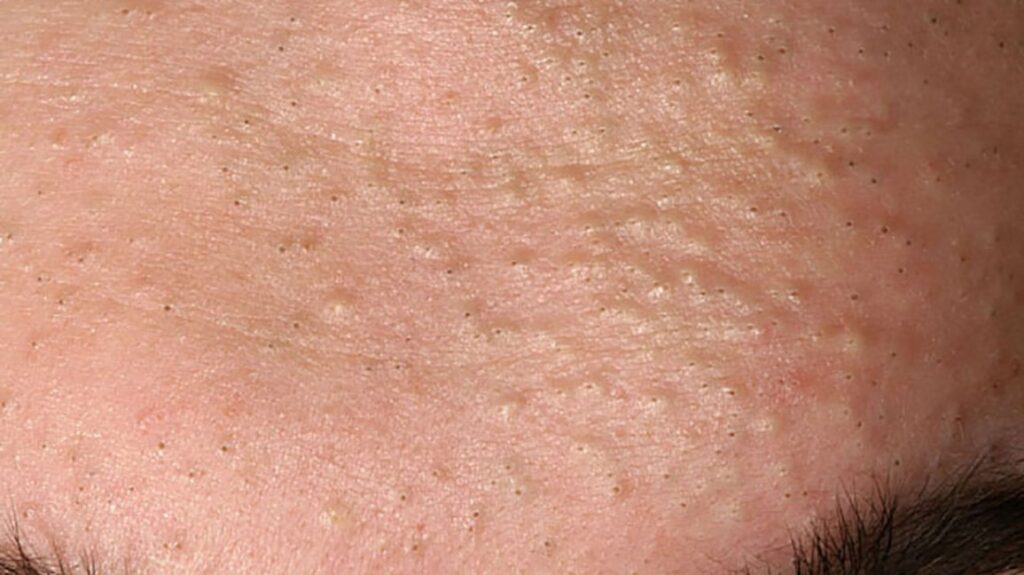
Comedones are skin-coloured bumps frequently found on the forehead, chin and other parts of the body. These common bumps are grouped into wo whiteheads and blackheads.
Cause: They are caused by the same thing – pore clogged with oil. Blackheads are black in colour with its top open while that of whiteheads generally have a closed top with the inside white, somewhat pink or flesh colored i.e. having any of the shades of the human skin.
Treatment: While comedones aren’t harmful, they can be annoying. Avoid squeezing them as it pushes the bacteria into your skin – causing more trauma. Treatment includes maintaining a good skincare regimen. Wash your face at least twice daily, use a facial cleanser that contains at least 2 percent salicylic acid – helps to get rid of clogged pores and avert future breakouts.
Salicylic, benzoyl peroxide, retinoids, azeloic acid and oral antibiotics may also help be very useful. Tip – do not use pore strips to remove blackheads, the adhesive used can cause damage to your complexion.
2. Milia

Milia are tiny, hard white bumps beneath the skin occasionally around your eye, mouth, nose, cheeks and eye area. They share keen resemblance with whiteheads but without the redness the comes with acne. Picking milia and attempting to pop them has little or no effect on it.
Causes: They are formed when dead keratinized skin cells and oils are not exfoliated and get keratinized skin cells and oils are not exfoliated, get trapped under your skin. Milia is common among newborns and also people with
- Skin condition like rosacea
- Use oil-based makeup and skincare
- Skin trauma like burns
- Under exfoliate and do not properly cleansing their face everyday
Treatment: Milia aren’t harmful and do not go away. If it bothers you include alpha hydroxy acids (AHAs) like glycolic or lactic acid that help in exfoliating. To have it completely removed consider extraction options which work for you with your dermatologist.
Other remedies for smoother skin include
- Using cosmetics and skincare productions that offer hydration such as hyaluronic acid.
- Add a serum to your skincare routine
- Apply sun protection daily
- Try using a gentle physical exfoliation to remove dead skin cells
3. Inflamed Pimples
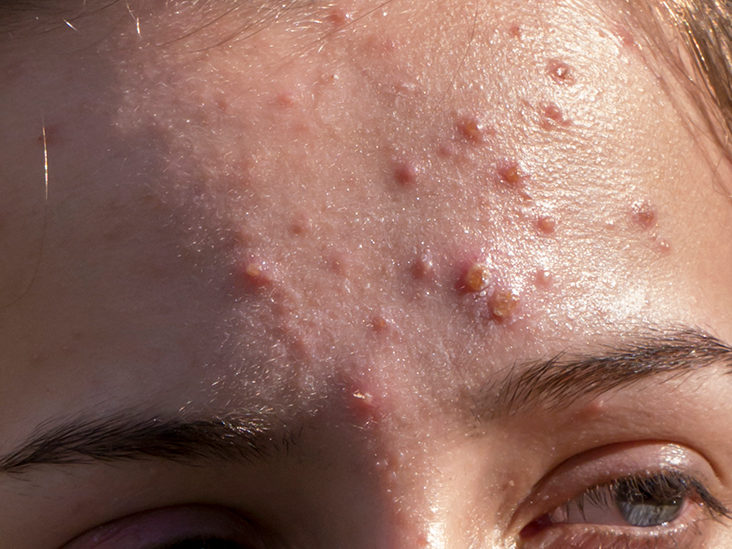
Copyright: Charles Bowman
Inflamed pimples are a type of inflammatory acne that appear as painful bumps on the face. They occur as pus filled bumps sometimes with a red circle surrounding it. They are often red, painful and swollen. Avoid picking these bumps, it only aggravates the inflammation and redness. It can also cause a permanent scar.
Causes: Inflamed pimples/cystic acne occurs when pores become clogged – normally with dead skin cells. If bacteria also get trapped, the area become noticeable red and swollen. According to Dr. Schlessinger to Women’s Health, he says “Cystic acne is caused by hormonal fluctuations and acne bacteria”, he continues to say that this triggers an overproduction of oi causing pores to swell.
Dr Gonzalez to Women’s Health adds that other causes includes bacteria in hair follicles and slowed cell turnover in acne patients that lead to keratin increase in pores.
Treatment: OTC drugs cannot effectively treat inflamed pimples, instead book an appointment with your dermatologist. Treatment may include:
- Oral contraceptives – which help regulate your hormones
- Oral antibiotics – to control bacteria and inflammation
- Benzoyl peroxide – cleanses containing benzoyl peroxide help reduce breakouts
- Retinoids i.e. Vitamin A in gel, cream, lotion or foam help increases the effectiveness of antibiotics.
Other treatment options include spironolactone, steroids, isotretinoin (which should only be taken under guidance of your dermatologist).
4. Ingrown Hairs

Ingrown hairs in shaved skin and can affect anyone with either curly or coarse hair. An ingrown hair occurs when growing hair curls instead of growing above the skin – this deviation causes the hair to get trapped beneath the skin’s surface, which usually appear as a small red bump with or without pus often with itchiness and inflammation.
An ingrown hair occurs primarily after puberty. It is commonly seen in the bikini area of women especially among the Black race with thicker, tight curled hairs. Although, medically harmless it may cosmetically disfiguring. It’s never a good idea to use tweezers or manual force to pluck them as it only makes inflammation and irritation worse.
Causes: Ingrown hair is caused by
- Waxing, shaving or plucking hair
- Hair cut to close or below your follicular opening i.e. outer layer of your skin
- Improper shaving techniques
- Friction from tight clothing
Treatment: Although an ingrown hair can automatically go on its own, washing your skin with mild soap and also lubricating skin with shaving cream gel before shaving goes a long way in limiting ingrown hairs. Good shaving practices like replacing dull blades with fresh one reduces risk of ingrown hair. Apply hydrocortisone creams to reduces redness and inflammation.
Other treatment options of ingrown hairs include:
- Use of chemical depilatories – a cosmetic product that’s used for hair removal like Veet.
- Hair laser removal which is along term solution
- Exfoliating before shaving a couple of days after helps remove dead cells and limits ingrown hair.
P.S. Best results are achieved with combination therapy.
5. Moles
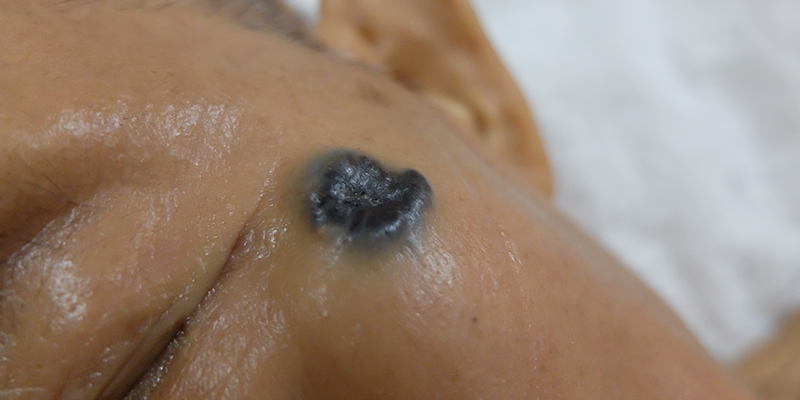
Moles are perfectly normal and most at times harmless. Doctors say at least one mole can be found on the skin of every single person. They often appear as small, dark brown spots on the face caused by cluster of melanocytes (melanocytes are cells that create melanin) instead of spreading out.
Healthy moles have defining characteristics:
- Distinct borders
- Flat or raised
- A uniform brown, red or flesh colored spots or bumps
- Overall symmetry i.e. round shaped
Although, most moles appear on the skin during childhood and adolescence – for adults new moles and noticeable changes in size and growth may be a sign of something more serious especially melanoma (skin cancer).
According to Mayo Clinic, you should also see a doctor if your mole has
- Asymmetrical shape
- An irregular border
- An uneven or changing color
- Bleeds or becomes more painful.
Causes: Moles is caused by sun exposure and genetic factors.
Treatment: A noticeable anomaly in your mole should be checked by a dermatologist (skin doctor). Unless you feel bothered about it, moles are generally harmless. To remove a healthy mole, visit a dermatologist. To prevent multiplication and spreading wearing sunscreen before going out, goes a long way.
6. Keratosis Pilaris
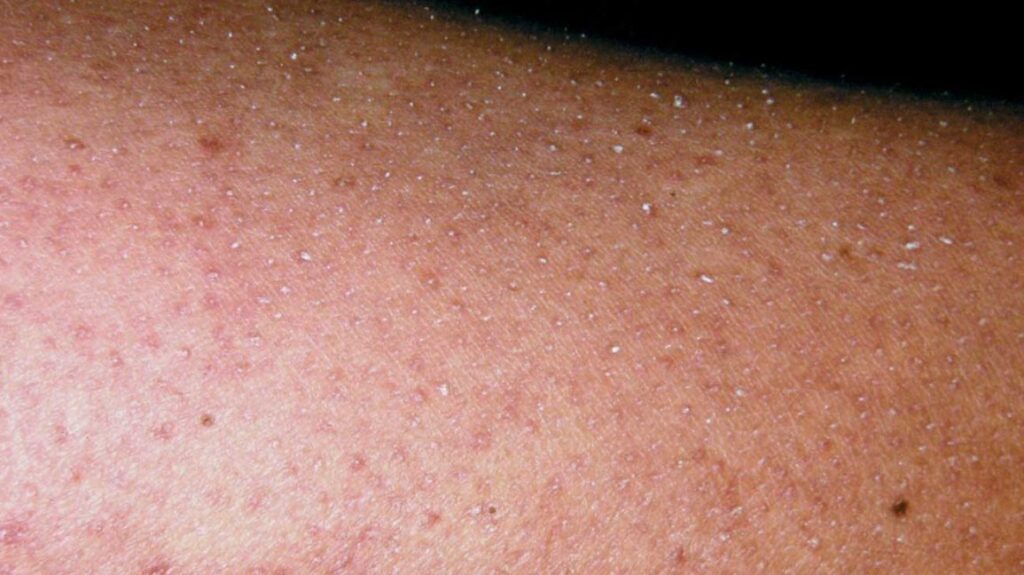
These tiny bumps are mostly confused as goose bumps or pimples. They appear most commonly on the cheeks, thighs and buttocks as red, rough bumps. No need to fret – Keratosis Pilaris is totally harmless.
Cause: It is a genetic condition caused by keratin accumulation which blocks the hair follicles. Dr. Farber MD, FAAD at Schweiger Dermatology Group to Dermstore says people with dry skin and eczema are more susceptible to Keratosis Pilaris.
Treatment: Dr Engelman to Women’s Health says to avoid squeezing or picking “Squeezing or picking these lesions causes worsening effects like redness and the potential for scarring as well”.
Though no treatment is required, since the condition improves with a age – moisturizing and exfoliating regularly can help with smoothing your skin. Use chemical exfoliant that contain salicylic and glycolic acid. If it seems to get worse, visit a dermatologist for more treatment options.
7. Xanthelasma
Xanthelasma are soft yellowish deposits of cholesterol found under the skin. They appear as white to yellow irregularly shaped bump commonly seen on the eyelids. Xanthelasma is often associated with high cholesterol level, hence, the need for immediate checkup by a doctor,
Causes: Cutaneous Xanthelasma is caused by
- High (bad) cholesterol pr low (good) cholesterol
- Liver disease which increases cholesterol levels
- Liver disease which increases cholesterol level
- Genetics – familial hypercholesterolemia, which is genetically inherited.
Treatment: the plaques can be removed by surgery, cryotherapy (freezing it off with intense cold)
8. Dermatosis Papulosa Nigra (DPN)
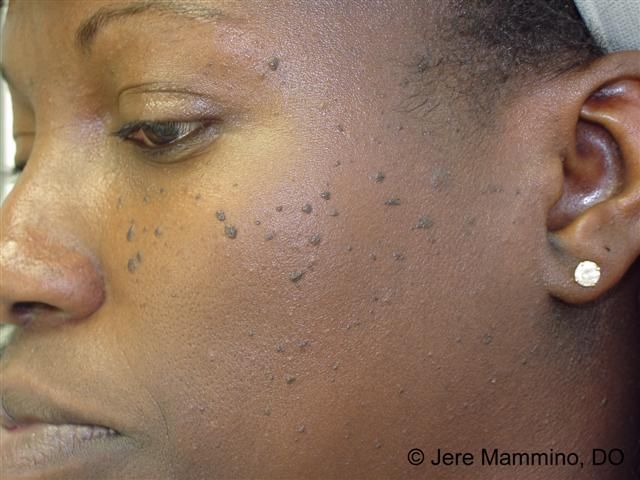
This is a harmless skin condition predisposed to people with darker skin tone and is most at timed genetic, not to be confused with moles Dermatosis Papulosa Nigra (DPN) are brown, dark bumps that appear on the face and neck.
Cause: The cause of DPN is unknown for now but healthcare providers link these tiny bumps to genetics. They are smooth, round and flat superficial buildup of epidermal cells.
DPN usually starts during adolescence with the amount varying from one to another.
Treatment: While DPN is totally harmless and requires no treatment, the Skin of Color Society say in office removal treatments of DPN include:
- Scissor excision
- Shave excision
- Laser removal
- Dermabrasion
- Curettage
- Cryosurgery
- Electrodessication
9. Skin Tags
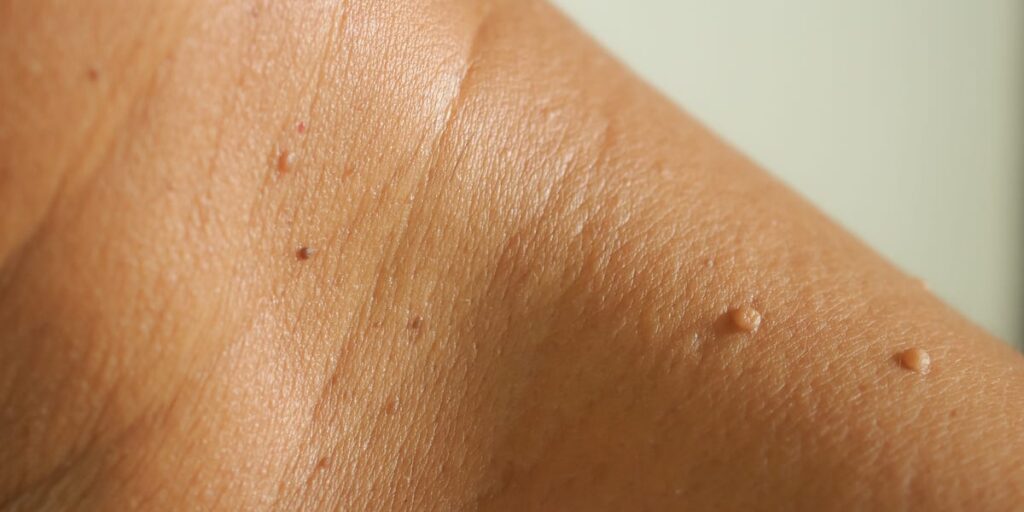
A skin tag is common skin growth usually oval-shaped that normally occurs on the face, neck and underarms. They connect to the skin via a stalk. These tiny bumps are totally harmless but can also be an annoying skin problem – avoid picking them, they bleed and cause pain when you do.
However, if you notice distinctive changes like –
- Change in color ‘becomes infected
- Painful in any way
See a dermatologist immediately.
Causes: It’s unclear what causes skin tags. Bruce Katz, MD, a dermatologist in New York City to Women’s Health “They often occur in areas of friction like by the neck, underarms and groin – they are thought to be caused by skin rubbing on skin or on clothing”.
Skin tags have also been linked to genetics, a common side effect of pregnancy, obesity, HPV and type 2 diabetes. Other causes include wearing a lot of jewelry.
Treatment: Aside there’s no aesthetic reason to remove them. Seek professional help from a dermatologist to remove them. Seek professional help from a dermatologist to remove by cauterizing them, cutting hem off, freezing them.
10. Sebaceous Hyperplasia
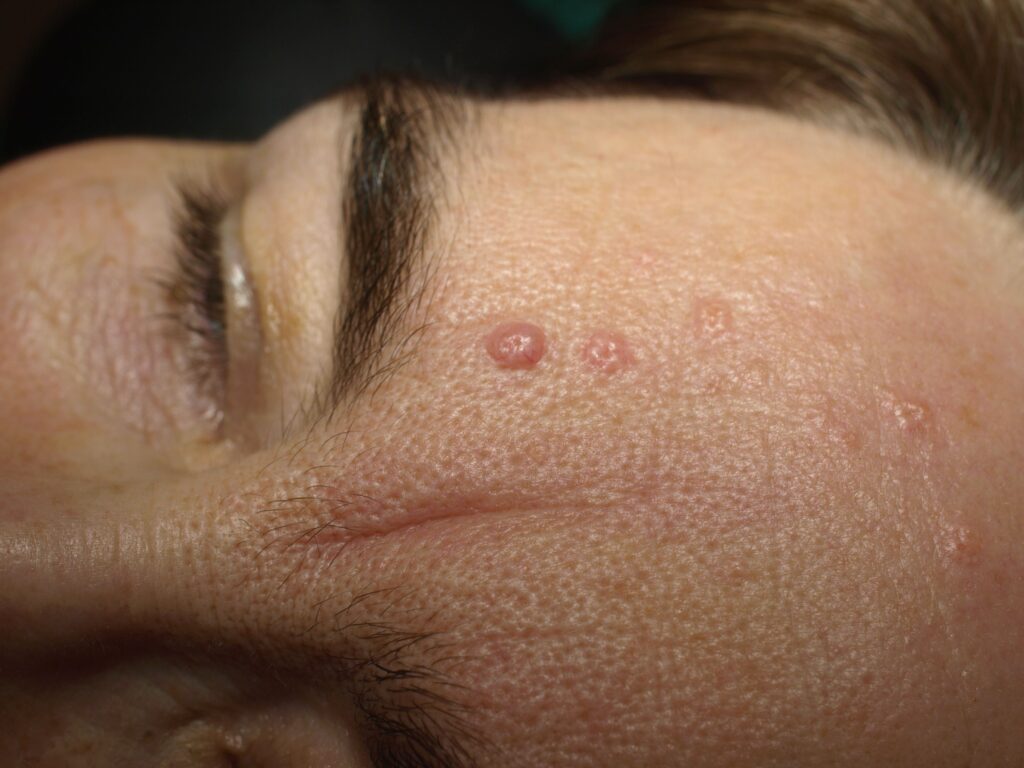
Sebaceous Hyperplasia is a common benign skin lesion. It occurs when the sebaceous gland becomes enlarged with trapped sebum. They appear as white, yellowish or skin colored bumps on the forehead and center of the face.
Causes: People with fair skin, especially those with excess sun exposure are more prone to Sebaceous hyperplasia. It is likely genetics, mostly seen in people with family history. Linked to Muir-Torne syndrome, it can be a sign of a tumor in people with this rare genetic disorder.
Treatment: Though harmless treatment includes –
- Isotretinoin
- Cryotherapy
- Laser treatment
11. Papular Eczema

Popular eczema are bumps that occur due to eczema. These bumps, called papules are small rashes and itchy.
Causes: There’s no known cause of eczema. Popular eczema is more likely to affect people with darker skin or African – American people.
Treatment – There’s presently no cure for eczema although a wide range of treatments and remedies are available to ease symptoms – depending of the type and severity of eczema.
This includes OTC treatments, phytotherapy biological medications.
Home remedies include:
- Using gentle fragrance – free products.
- Less shower time, with lukewarm water.
- Moisturizing frequently with coconut oil, aloe vera gel, apple cider vinegar, sunflower oil
12. Lipoma
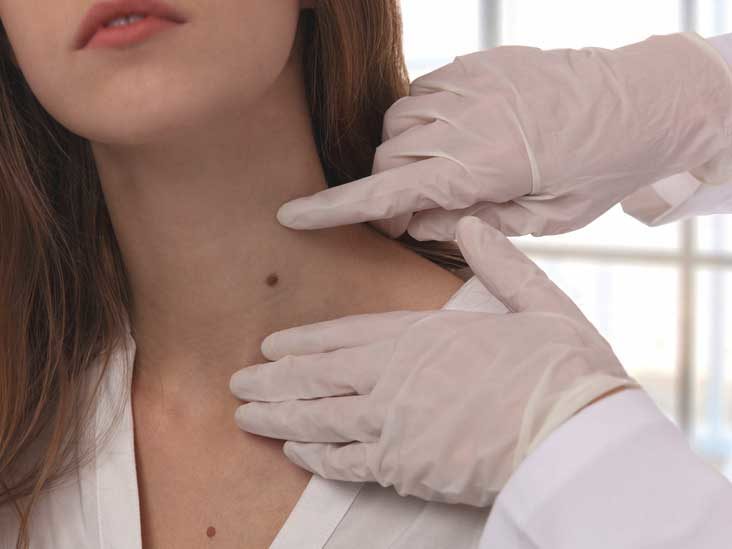
Lipoma is a lump underneath the skin caused by accumulation of fatty deposit. Lipomas are considered to be benign tumors by doctor – meaning they are non-cancerous and generally harmless.
Cause: The cause of Lipoma has not been fully understood but it has often genetically linked. If you notice changes like
Increase in pain
- Pain accompanied with red or hot sensation
- Visible changes in the overly skin
- Turning hard
then you should see a doctor.
Treatment: Surgically removal is the best treatment option. Lipoma is removed for various reasons
- Cancerous
- Cause pain and discomfort
- Cosmetic reasons
13. Cherry Angiomas
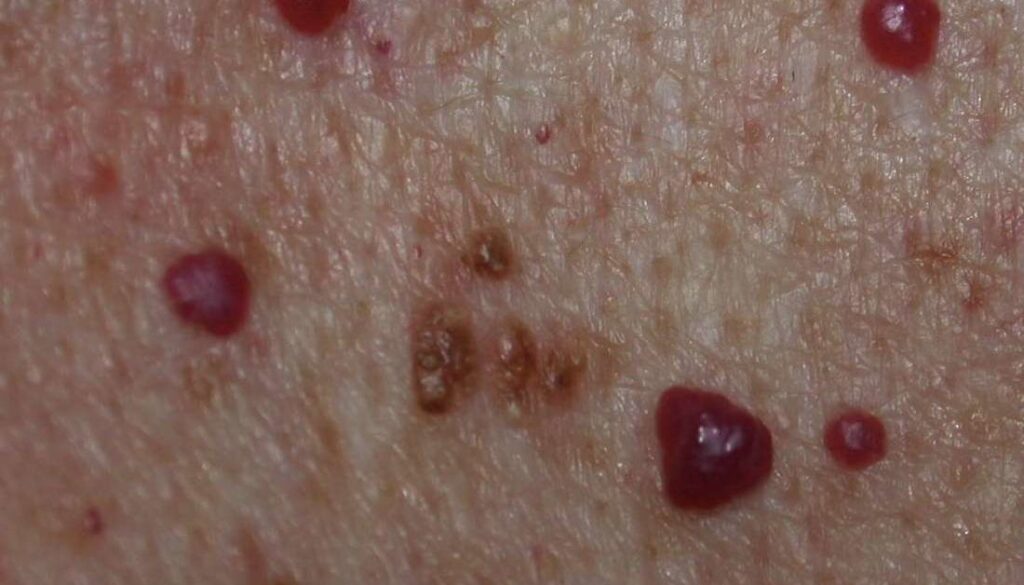
Cherry Angiomas or red moles are benign bumps that pop on the face, belly, chest and back. It contains a collection of blood vessels responsible for its reddish appearance.
Cause: Like Lipomas’ the cause of cherry angiomas is unknown and it’s linked to genetic factors that predisposes certain people more likely to get than others.
Treatment: Common procedures for removing red moles include
- Cryosurgery
- Electrocauterization
- Laser surgery
14. Sebaceous cysts
Sebaceous cysts are common noncancerous cysts that contain yellow cheese like substances. They are asymptomatic large cysts that contain yellow cheese like substances.
Causes: This pimple look alike is caused by keratin buildup under the skin – especially on areas with concentration of sebaceous glands. Sebaceous gland produces the oil that coats your skin and hair. Sebaceous cysts are usually found on the scalp, face. Back and neck.
Treatment: Cysts are treated by draining or surgically removal, usually for cosmetic reasons.
15. Bumps due to Rosacea
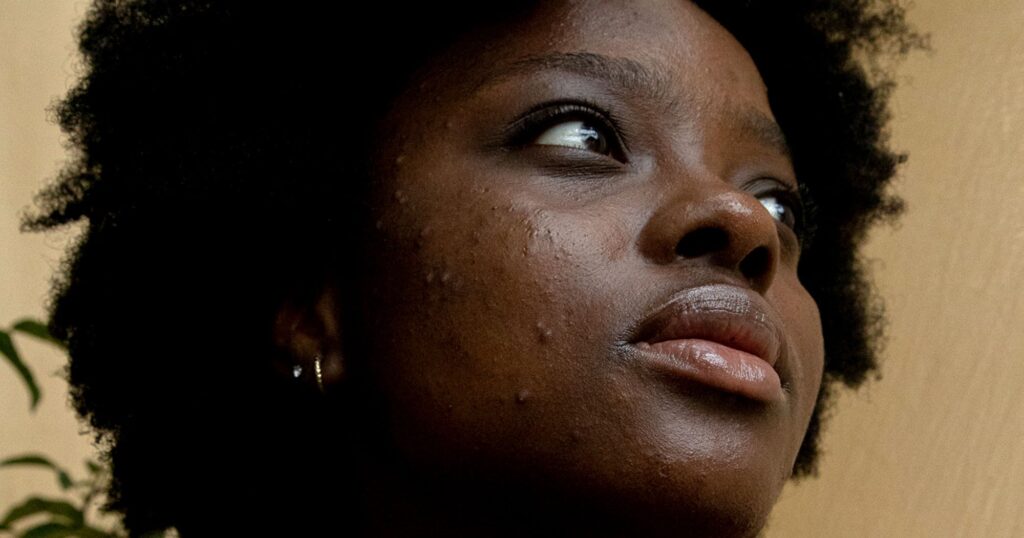
Rosacea is a common facial skin disorder that causes redness on the chin, nose, forehead and cheeks. Overtime if not properly treated rosacea can cause red solid bumps and pus-filled pimples in some patient.
Causes: the cause of rosacea is unknown. Condition like exercise, alcohol, sun exposure, cosmetics, skincare products can trigger it causing inflammation of the skin. Rosacea is often seen with people with dry skin.
Treatment: Treatment options include use of
- Topical azelaic acid
- Topical prescriptions
- Oral antibiotics
Avoiding exposure to triggers is key in decreasing the inflammation that causes the redness and bumps.
16. Seborrheic Keratosis
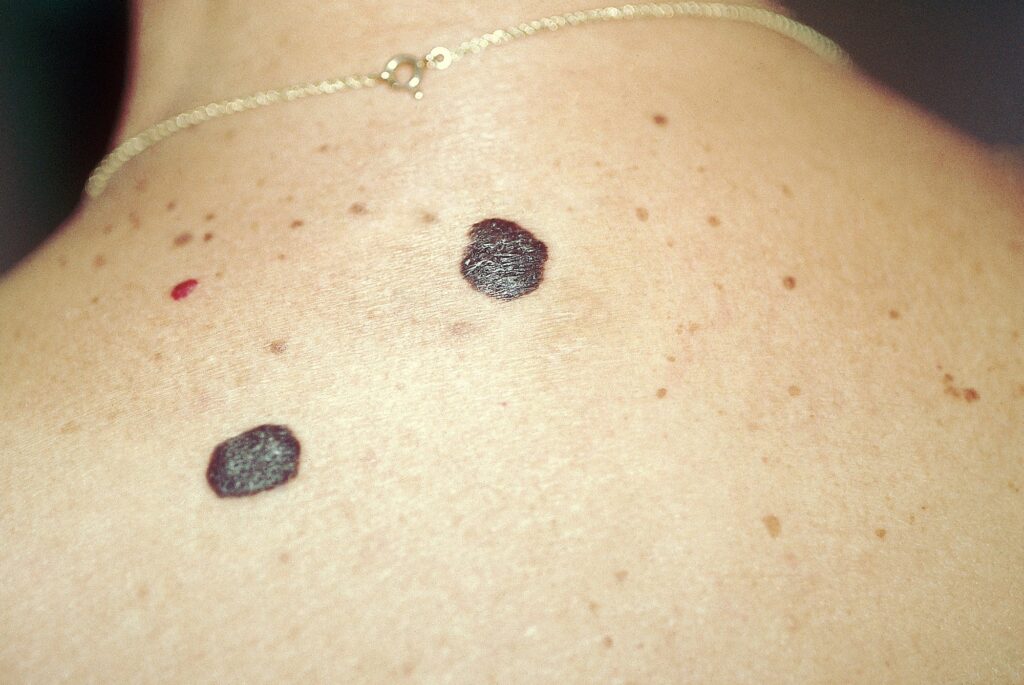
Seborrheic keratosis is a type of skin growth mostly found on areas of the body exposed to he sun through growth can be found on any part of the body except the soles of he feet or the palms.
Causes: The skin condition often runs in families. Evidence support that frequent sun exposure to sun also contributes.
Treatment: A seborrheic keratosis doesn’t need treatment, however, common methods of removal include
- Cyrosurgery
- Electrosurgery
- Curettage

